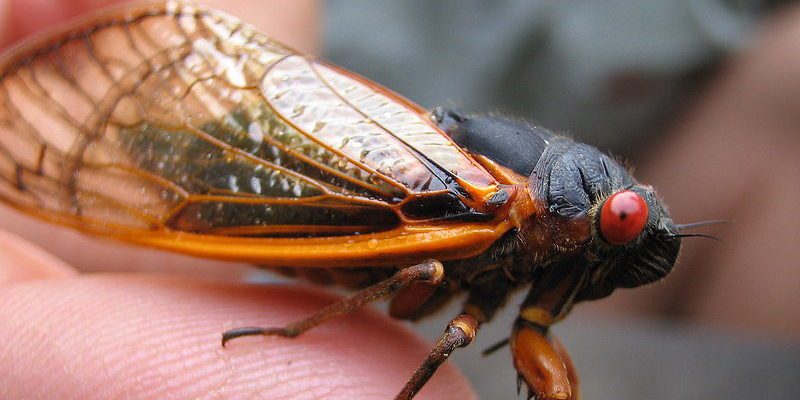
These insights on the cicadas of Brood II have been shared by Jim Woodworth and Jessica Sanders, our Tree Planting Director and Technical Services & Research Director.
If you haven’t heard a Cicada under a warm night sky, prepare yourself for the deafening sound of their monotonous buzzing and clicking, which at times are loud enough to drown out planes overhead. Cicadas live underground as nymphs for most of their lives, eventually exiting through a tunnel to the surface and emerging to molt on a nearby plant and mature into adults. The abandoned exoskeleton remains, clinging to whatever surface it can, typically the bark of trees. Cicada nymphs suck sap from the xylem of various tree species. Post-coitus, the female cicada cuts slits into the bark of a twig and deposits her eggs, repeating the process until she has laid several hundred eggs. When the eggs hatch, the nymphs drop to the ground and burrow. This year is Brood II, which has a 17-year life cycle that is soon coming to an end. These nymphs have spent nearly two decades feeding on roots, and will burst into a mating frenzy once the ground temperature reaches 64 degrees Fahrenheit. The red-eyed insect will outnumber people living from North Carolina to Connecticut by 600 to 1.

Although benign to humans (they do not bite or sting), cicadas have been known to mistake an arm for a tree or plant limb and attempt to feed. Adult cicadas have a long proboscis which they use to feed on sap from plant stems. Cicadas can cause damage to crops, shrubs, and trees typically in the form of scarring left on branches while the females lay their eggs deep in the branches. Large swarms can damage young trees by feeding and laying eggs, but most established trees usually escape without serious damage. On mature, healthy trees even an increase of cicada activity should not concern you, as the trees will withstand the loss of branch ends and recover from the onslaught. Young trees, particularly ornamental fruit trees require the most protection, which can be done by draping netting (with openings less than ½ inch wide) over the canopy of young trees and securing it to the trunk. But in order for this to work, the netting must be placed before the cicadas emerge.
Although cicadas do cause damage to trees, they do have a benefit as well. The decomposing bodies of the adult cicadas will trap nutrients close to tree roots and act as a fertilizer; however, at the same time, those nutrients will feed the new generation of cicadas developing underground (emerging in 2030) and that process can slow tree growth by up to 30%. The tunnels created by the larvae will also act as a soil aerator.
One of the most interesting facts about cicadas is their defense mechanism against predators, known as predator satiation. This means that since so many cicadas emerge at once, the overwhelming number of cicadas is greater than any predator could possibly consume, therefor all predators are full and the remaining cicadas can breed without fear. One of my own personal laughs comes from watching my dogs attempt to stalk and eat the cicadas, only to be overwhelmed by the shear amount of them.
One way or another, the cicadas will continue to emerge like clockwork. Enjoy nature’s nightmusic, kickback on the deck or patio and raise your glass of wine or beer to toast one of nature’s peculiar phenomenons.
Other resources:
- General info: cicadamania.com.
- VIDEO: Washington Post.
- Cicada netting.

